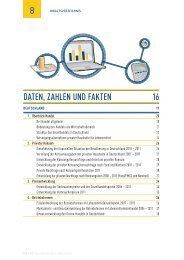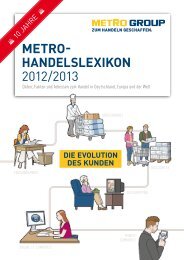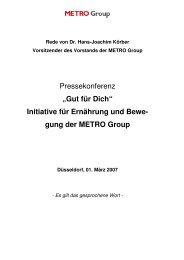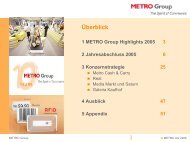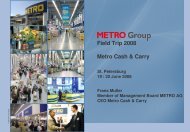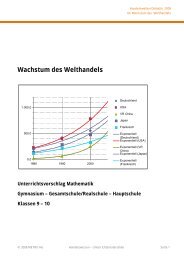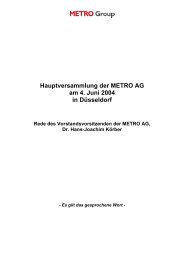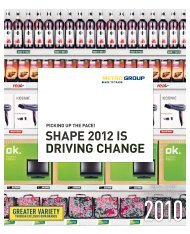pdf (2.5 MB) - METRO Group
pdf (2.5 MB) - METRO Group
pdf (2.5 MB) - METRO Group
Create successful ePaper yourself
Turn your PDF publications into a flip-book with our unique Google optimized e-Paper software.
<strong>METRO</strong> GROUP : ANNUAL REPORT 2010 : BUSINESS<br />
→ GROUP MANAGEMENT REPORT : 11. RISK REPORT<br />
11. Risk report<br />
Risk management at <strong>METRO</strong> GROUP is an integral part of<br />
value-orientated business management. It helps the Company’s<br />
management to limit risk and exploit opportunities<br />
and is based on a systematic process of risk identification,<br />
assessment and control for the entire <strong>Group</strong>. Risks are<br />
internal or external events that can negatively impact the<br />
realisation of short-term objectives or the implementation<br />
of long-term strategies. They can also emerge from missed<br />
or poorly exploited opportunities. we define opportunities<br />
as possible successes that extend beyond the defined objectives.<br />
within the framework of risk management, we recognise<br />
unfavourable developments at an early stage and put<br />
the necessary countermeasures into place. In addition, we<br />
also systematically identify, assess and seize positive <strong>Group</strong>wide<br />
opportunities.<br />
Centralised management and efficient<br />
organisation<br />
<strong>METRO</strong> GROUP’s risk management officer continuously and<br />
promptly informs the Management Board of <strong>METRO</strong> AG of<br />
important developments in risk management. Based on an<br />
annual <strong>Group</strong>-wide risk audit, the risk management officer<br />
writes the risk report. The most critical responsibilities of<br />
central risk management include ensuring the <strong>Group</strong>-wide<br />
exchange of information on risk-relevant issues and developing<br />
risk management in all sales divisions and <strong>Group</strong><br />
units. This involves coordinating the <strong>Group</strong>-wide recording<br />
and systematic assessment of all essential risks according<br />
to uniform standards. The risk management officer compiles<br />
the results in a risk portfolio that provides the basis for<br />
determining <strong>METRO</strong> GROUP’s total risk and opportunities<br />
situation.<br />
<strong>Group</strong>-wide risk management tasks and responsibility<br />
for risk management are clearly regulated and mirror<br />
<strong>METRO</strong> GROUP’s corporate structure. This combines centralised<br />
management by the management holding company<br />
<strong>METRO</strong> AG with the decentralised operating responsibility<br />
of the individual sales divisions. The sales divisions and consolidated<br />
subsidiaries are thus responsible for the risks, in<br />
particular operating risks. They oversee risk management,<br />
while <strong>METRO</strong> AG supervises its implementation. The Supervisory<br />
Board and its Accounting and Audit Committee work<br />
intensely on risk management.<br />
EBIT after Cost of Capital (EBITaC) as a<br />
risk assessment metric<br />
→ p. 129<br />
The value contribution, which we calculate as EBITaC (EBIT<br />
after Cost of Capital), is a key benchmark for corporate<br />
success. This represents EBIT including special items from<br />
Shape 2012 periodised over four years less the costs of capital.<br />
The degree of readiness to assume risk also focuses on<br />
this key metric and thus follows the principle of sustainably<br />
increasing enterprise value. In principle, <strong>METRO</strong> GROUP<br />
takes entrepreneurial risks only if they are manageable and<br />
if the opportunities involved promise reasonable value added.<br />
Strict risk policy principles<br />
Risks incurred in conjunction with the core processes of<br />
wholesale and retail trading are borne by <strong>METRO</strong> GROUP.<br />
The core processes include the development and implementation<br />
of business models, decisions on store locations, the<br />
procurement and sale of merchandise and services, human<br />
resources development relating to specialists and managers,<br />
as well as liquidity protection. In principle, we do not<br />
assume risks that are not related to these core processes<br />
or support processes.<br />
Clearly defined risk management details<br />
The coordinated application of risk management tools is<br />
assured by the compilation of all relevant facts in guidelines.<br />
These include the Articles of Association and by-laws of<br />
<strong>Group</strong> companies, internal <strong>Group</strong> procedures and the risk<br />
management manual of <strong>METRO</strong> AG that provides information<br />
on how the risk management system works, offers a<br />
comprehensive overview of potential risk areas, assigns<br />
responsibility for monitoring and provides instructions on<br />
how to act. The risk management manual is continuously<br />
reviewed and updated. Risks, as well as opportunities, are<br />
identified in a bottom-up process that extends through all<br />
management levels. An early-warning system assesses<br />
business risks in terms of scope for a planning period fixed<br />
at three years.<br />
<strong>Group</strong> reporting promotes internal<br />
risk communication<br />
<strong>Group</strong> reporting is the central vehicle for internal risk communication.<br />
It is complemented by risk management reporting.<br />
The aim is to allow for the structured and continuous






